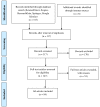Intelligent systems for additive manufacturing-based repair in remanufacturing: a systematic review of its potential
- PMID: 34977355
- PMCID: PMC8670367
- DOI: 10.7717/peerj-cs.808
Intelligent systems for additive manufacturing-based repair in remanufacturing: a systematic review of its potential
Abstract
The conventional component repair in remanufacturing involves human decision making that is influenced by several factors such as conditions of incoming cores, modes of failure, severity of damage, features and geometric complexities of cores and types of reparation required. Repair can be enhanced through automation using additive manufacturing (AM) technology. Advancements in AM have led to the development of directed energy deposition and laser cladding technology for repair of damaged parts and components. The objective of this systematic literature review is to ascertain how intelligent systems can be integrated into AM-based repair, through artificial intelligence (AI) approaches capable of supporting the nature and process of decision making during repair. The integration of intelligent systems in AM repair is expected to enhance resource utilization and repair efficiency during remanufacturing. Based on a systematic literature review of articles published during 2005-2021, the study analyses the activities of conventional repair in remanufacturing, trends in the applications of AM for repair using the current state-of-the-art technology and how AI has been deployed to facilitate repair. The study concludes with suggestions on research areas and opportunities that will further enhance the automation of component repair during remanufacturing using intelligent AM systems.
Keywords: Additive manufacturing; Artificial intelligence; Conventional methods; Intelligent systems; Repair and restoration.
©2021 Mad Yusoh et al.
Conflict of interest statement
The authors declare there are no competing interests.
Figures







References
-
- Afrinaldi F, Liu Z, Taufik, Zhang HC, Hasan A. The advantages of remanufacturing from the perspective of eco-efficiency analysis: a case study. Procedia CIRP. 2017;61:223–228. doi: 10.1016/j.procir.2016.11.161. - DOI
-
- Akinode JL, Oloruntoba SA. Artificial intelligence in the transition to circular economy. American Journal of Engineering Research (AJER) 2020;9:185–190.
-
- Al Handawi K, Andersson P, Panarotto M, Isaksson O, Kokkolaras M. Scalable set-based design optimization and remanufacturing for meeting changing requirements. Journal of Mechanical Design. 2020;143:021702. doi: 10.1115/1.4047908. - DOI
-
- Amelia L, Wahab DA, Che Haron CH, Muhamad N, Azhari CH. Initiating automotive component reuse in Malaysia. Journal of Cleaner Production. 2009;17(17):1572–1579. doi: 10.1016/j.jclepro.2009.06.011. - DOI
-
- Andrew-Munot M, Ibrahim RN. Remanufacturing process and its challenges. Journal of Mechanical Engineering and Sciences. 2014;4:488–495.
LinkOut - more resources
Full Text Sources
